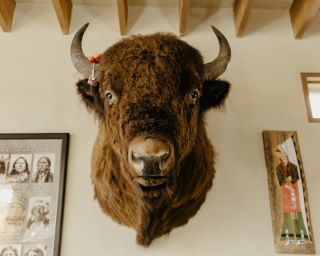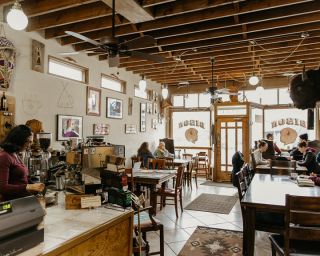Native American Community
Learn more about Portland's vital Native American community.
This section was produced in collaboration with 1000 Nations and the Oregon Native American Chamber.
Portland’s urban Native community is descended from more than 380 tribes, and there are nine sovereign Native American nations located throughout Oregon. Each nation inhabits their own reservation and welcomes visitors in their own way, according to their respective customs and traditions.
History
The Portland metro area rests on traditional village sites of the Multnomah, Kathlamet, Clackamas, Chinook, Tualatin Kalapuya, Molalla and many other tribes and bands. These groups created communities and summer encampments along the Columbia and Willamette rivers and harvested and used the plentiful natural resources of the area for thousands of years.
Portland’s Native American Youth and Family Center (NAYA), which hosts cultural programming and other events, is located on what, to the Native community, is sacred ground in Multnomah county. The site in contemporary Northeast Portland is recognized as the original location of an Indian village known as Neerchokikoo, dating to before 1792 and cited in Lewis and Clark’s journals.
Oregon’s population was largely Native American until relatively recently. The Oregon Donation Land Act of 1850 and accompanying legislation removed tribes and offered free land to white settlers, who laid claim to 2.5 million acres of tribal land — including all of what is now Portland — over the course of just seven years.
Mentioned Elsewhere Online
Travel Oregon
Oregon Public Broadcasting
Museums & Art
In Portland you’ll find several spectacular collections of Native American art that celebrate the rich cultural diversity of the region.
The Oregon Historical Society houses one of the largest photo archives west of the Mississippi, documenting the changing landscape of the West over the last two centuries. The museum is also home to a vast array of Native American basketry, beadwork and carvings.
At the Portland Art Museum, you can view traditional carvings, basketry, paintings, and sculptures from tribes throughout the Northwest. The museum’s Native American Art Council hosts lectures and public displays by local and regional artists throughout the year.
Many shops and galleries in Portland feature Native American art, jewelry, and crafts. One established gallery can be found in downtown Portland, featuring Native art and antiques, Arthur W. Erickson, Inc.. Created in 1972, Quintana Galleries is home to a robust collection of Native American, First Nations, Arctic and Mexican art. The gallery’s extensive assortment of jewelry, paintings, pottery, sculpture and more is available exclusively online and by appointment only.
Founded in 2013 to increase access to music education, celebrate Native American culture and honor this remarkable musician’s legacy, The Jim Pepper Native Arts Festival is a free event that is held annually at Parkrose High School. The festival takes place outdoors with dancing on the lawn and Mount Hood views.
More Oregon Tribal Museums
Explore tribally-owned museums such as the Tamástslikt Cultural Institute on the Umatilla Reservation (210 miles east of Portland in Pendleton, Ore.) or the Museum at Warm Springs on the Warm Springs Reservation (100 miles southeast of Portland).
The various tribal museums, with their permanent and changing exhibits, strive to show not only who Native Americans of Oregon were before contact with Caucasians, but who these indigenous communities are today and who they plan to be in the future.
Portland’s Native American Community
Bison Coffeehouse Celebrates Indigenous Culture
Deep in the Cully neighborhood of Northeast Portland, passersby might miss unassuming Bison Coffeehouse if going by too quickly. Once inside, however, visitors will discover there is nothing unassuming about this coffee shop at all. With a giant bison head mounted between intricate paintings and photographs of Native culture and landscapes, it’s easy to see how much thought has been put into the space.

Owner Loretta Guzman, a Shoshone-Bannock tribal member, was born and raised in Portland. In 2012, Guzman asked her father if she could use the building he’d owned for years to open her own coffeehouse. It was hardly a whim — Guzman had spent several years researching everything in the coffee industry. She decided to pair her learnings with her self-taught cooking and baking experience to start a new business.
Dreams of Bison
Guzman originally planned to become a dental lab technician and began working in coffee shops to put herself through school. But in 2008, she was diagnosed with Hodgkin lymphoma. Between her illness and the recession’s impact on the dental industry, she decided to pursue a different career.
During this time, Guzman had a vivid dream of a giant bison continually trying to approach her. When she told her stepfather, he told her it was her grandfather, who used to dance for the bison. Unbeknownst to Guzman, her stepfather had been praying that her grandparents in the spirit world would help her fight her illness. Soon thereafter, in 2009, Guzman went into remission.
Five years later, she named her coffeehouse “Bison” in tribute.

Opening Bison Coffeehouse
Guzman spent two years fixing up her father’s building — and a lot of time figuring things out on her own, and with the help of her family — before opening the shop in 2014.
“Nobody gives you fine-tuned training about coffee and the industry as a whole, especially if you don’t have their ‘look,’” Guzman explains. “So I took what I liked from the coffee industry and left what I didn’t.” Guzman was determined to incorporate her Indigenous culture and identity into Bison, which would be Portland’s first Native-owned coffee shop.
At Bison, visitors will find chai from Portland-based Tanglewood Chai Beverage Company and bagels from Bowery Bagels. The rest of the shop’s delectable baked goods are made in-house by Guzman herself. On any given day, patrons might enjoy bison-shaped cookies with colorful icing, flaky bacon cheddar biscuits, ricotta cake dusted with powdered sugar, chewy nut bars or lemon olive oil cake.
Connecting to the Native Community
Bison also stocks buffalo jerky produced by Guzman’s Shoshone-Bannock Tribe in Fort Hall, Idaho. The shop brews coffee from local Coava Roasters, but also proudly serves two blends from Indigenous roasters: Star Village and Native Coffee Traders.
Bison’s celebration of Native culture extends to their decoration, as well. The walls are covered with Indigenous artwork collected by Guzman’s family and framed photographs of Guzman’s ancestors. Also on display are a beautiful burden basket sourced from the Apache tribe in Arizona, a large blanket gifted to Bison on its third anniversary by Pendleton Woolen Mills and hand-carved wooden statues of Indigenous figures.

Bison Coffeehouse also helps connect the Indigenous community in a number of more tangible ways. The shop hosts regular poetry readings and community alliance gatherings; sells ornaments and dolls to raise funds for organizations focusing on missing and murdered Indigenous women (MMIW); and gathered a tremendous outpouring of supplies, donations and support for the Standing Rock Sioux tribe. In 2016, Bison also hosted campaign gatherings (and a victory party) for Tawna Sanchez, the second Native American to serve in the Oregon legislature.
Guzman hopes to continue bringing the Native community together and educating Portlanders about Indigenous history and contemporary Native issues.
“I hope more Natives continue to do more and know they have value,” she says. “I hope to see our people continuing to support efforts and see if I can do it, they can do it too. Our past ancestors and the choices they made are why we are here right now. I owe a lot to them and they are here in spirit every single day. The things you do … you gotta make them count.”
Events
Depending upon the time of year, you may find a powwow, a salmon fest or other indigenous community events within easy reach during your stay in Portland. For a calendar of events curated by local tribes, see the Portland Indian Leaders Roundtable website and its Native Connect e-newsletter.
Indigenous Events
Explore and celebrate Portland's Indigenous culture at these upcoming events.
Was this page helpful?